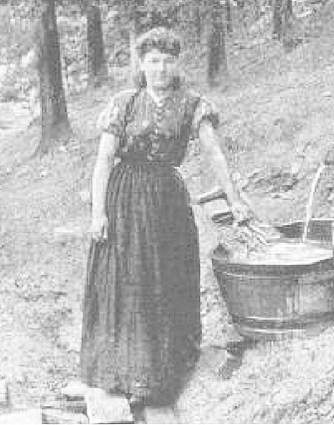The haunting of Militia Hill

Is the spirit of this woman haunting Militia Hill?
Everyone knows about the efforts of the Coal Creek Watershed Foundation in restoring not just the pristine waters of Coal Creek, but also restoring the place in history — and sense of pride — for the entire watershed.
Barry Thacker and Carol Moore have put in countless hours, tremendous energy, and have recruited the residents along the watershed to make a difference.
But early setbacks almost derailed the work to have the historical significance of the Coal Creek region recognized.
All because of a haunting of the most mean-spirited kind.
Ida Knowe is a phantom haunting Militia Hill in the Wye Community of Coal Creek.
She dumps trash and junk on her haunting ground due to some unknown act perpetrated against her when she was alive.
Everybody remembers her name, but nobody knows why she haunts Militia Hill.
People from all over are asked, “Can you solve this mystery?”
The backstory:
At the end of the Civil War in 1865, the populations of prisons in the south overflowed.
Southern states enacted the “convict lease system.” Rather than build more prisons, Southern states leased convicts to work for private companies. The venture was very lucrative for state government, and with time, the convict lease system became corrupt. Primarily African-Americans were arrested for petty crimes and sent to serve life (or death) sentences working on plantations, railroads, and in coal mines.
There were only three ways out of the convict labor system: escape, self-mutilation, or death. By the 1870’s, business owners and politicians started using convict laborers to replace striking workers and crush labor unrest.
Prison and labor reform movements of the time saw no end in sight for this cruel institution.
In 1877, Welsh immigrant coal miners working at the Knoxville Iron Company Mine in the Wye Community of Coal Creek went on strike. Convict miners were brought in and the Welsh immigrants lost their jobs. Mining jobs were plentiful in Coal Creek so the incident at the Knoxville Iron Company Mine received little attention and was soon forgotten.
In the summer of 1891, convicts were sent to replace striking miners in Briceville and Minersville in the Coal Creek Watershed. Miners who had lost their jobs traveled to Nashville to meet with Governor Buck Buchanan to try and resolve the situation. The Governor told them that Tennessee had a revenue problem and offered no help. No other elected officials could help, so the Coal Creek miners captured guards and convicts, put them on a train to Knoxville, and burned the convict stockades.
The Governor sent troops to Coal Creek to restore order. The Coal Creek miners captured the troops and put them on a train to Knoxville. Thus began the Coal Creek War, an armed conflict between the miners of Coal Creek and the Tennessee Militia over the use of convict labor.
In December 1891, the Tennessee Militia built Fort Anderson on Militia Hill as a stronghold from which to fight, but the Coal Creek miners kept coming at them. The soldiers fired Gatling guns and cannons from Militia Hill, but the miners kept coming at them.
The militia even captured and hung Coal Creek miner, Dick Drummond, but still the other miners kept coming at them.
In retaliation for the hanging of Dick Drummond, the Coal Creek miners laid siege to Fort Anderson.
Although the Coal Creek miners lost the final battle, public support for the miners, and the election of a new Governor in 1892, ended the convict lease system in Tennessee.
The earthen embankments and trenches surrounding the site of old Fort Anderson on Militia Hill are all that remain of the Coal Creek War. They serve as a monument to what the Coal Creek miners accomplished, that which prison and labor reform movements after the Civil War could not.
The hauntings
In April of 2001, volunteers removed trash and junk from Militia Hill, a site with historical significance that needs to be restored and preserved. The next day, more trash and junk appeared.
When asked who did the dumping, local residents all said, “Ida Knowe.” Another clean-up was followed by the appearance of more trash and junk.
When local residents were again asked who did the dumping, their answer was the same, “Ida Knowe.”
Sheriff’s deputies have started patrolling Militia Hill to stop the illegal dumping. When asked who dumps the trash, even they responded, “Ida Knowe.”
According to a source with the Sheriff’s office, “She must be one bad ghost because folks tell us she committed the crime and then they just keep repeating her name. Where does she live?... Ida Knowe. What does she look like?... Ida Knowe.”
Ms. Knowe has never been listed in a phone book, never paid taxes, and never gotten a driver’s license.
Only her spirit remains to haunt Militia Hill. If you visit Militia Hill to pay your respect sto the Coal Creek miners who ended the convict lease system in the South, please feel free to take some of the trash that Ms. Knowe has dumped as a souvenir. Maybe it will help solve this riddle.
Who was Ida Knowe and why can’t her spirit rest in peace?


